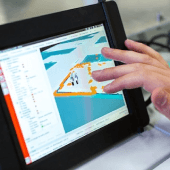Three steps to narrow down a penetrant method through governing specifications, part composition, and test parts
Governing specifications and work procedures often dictate the penetrant method type. Selection of the penetrant method is based on the part’s end use, safety considerations, part composition, surface finish, and any important factors specific to the part. Selection of the correct penetrant method is important to not only comply with specifications but to detect surface breaking indications on the parts easily. The selection of the correct penetrant method along with the correct sensitivity level will result in confidently detecting the indications that can be found in the inspected parts
Penetrant Methods
- Method A: Water washable
- Method B: Post emulsifiable, lipophilic
- Method C: Solvent removable
- Method D: Post emulsifiable, hydrophilic
1. Review governing specifications and work procedures
Often the penetrant method and sensitivity level are called out in the specifications and work procedures. In this case, the proper Magnaflux penetrant products can be selected based on method and sensitivity level with confidence that the Magnaflux products will meet the industry quality standards.
Use our Fluorescent Penetrant Product Comparison table, and our Visible Dye Penetrant Product Comparison table to see which products work with each method.
2. In the case where the penetrant method and sensitivity level is not specified, consider the following
Surface roughness and finish – Method A Water Washable (sensitivity levels 1 & 2) penetrants perform well on rough surfaces. Common applications include automotive castings such as steering knuckles, subframes, and housings.
Higher sensitivity penetrants (Methods A, B, D) are suitable for highly machined surfaces and safety critical parts.
3. Penetrant evaluation on actual test parts
Magnaflux recommends an evaluation on actual test parts with a few penetrants to determine the best choice penetrant for an application where the penetrant method and sensitivity level are not dictated in guidance documents. An evaluation on actual test parts establishes proper penetrant sensitivity and brightness with acceptable background fluorescence to detect the type of indication typically found on the parts. An evaluation on actual test parts will also establish the optimal processing parameters (dwell time, rinse time, dry time, developing time) for a given part.
Source: https://www.magnaflux.com/Magnaflux/Resources/Blog/Selecting-a-Method













